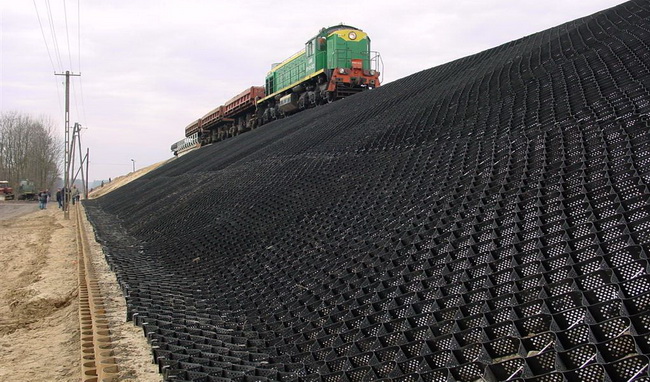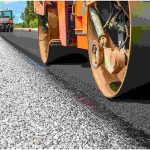Special attention during construction is of the utmost importance. Poor construction can result in costs in maintenance and repairs that are greater than the initial costs. Major factors affecting slopes are the intrusion of water and the slope too steep for the soil type. The problem of water intrusion can be minimized by following sound construction practices. Methods for grading to drain as outlined on page 8 can help keep surface runoff from eroding slopes. If the embankment is adequately crowned to promote drainage and good compaction is achieved along the outer edges of the slope and on the slope face itself, intrusion of water into the slope can be minimized. If the soil along the slope face is loose, it will provide a good area for grass seed to germinate, but as soon as a heavy rain hits the area heavy erosion and undercutting of the slope takes place which can lead to more serious problems if not properly repaired. If a grass bed is established, the zone of grass roots becomes saturated and there is nothing stable for the roots to establish anchorage. If this mass becomes laden with enough water, the grass and soil within the root mat slides down‐slope, exposing the soil which can then become further saturated.
The effects of weather falling directly on the slope can be minimized by properly compacting the face of the slope and seeding the slope as soon as practicable. Section 302 of the Specifications details the requirements for incremental seeding to make sure large areas of slopes are not exposed to the elements for extended time periods. To make sure of this, seeding operations are to be initiated within 48 hours after reaching the appropriate grading increment for seeding, or upon suspension of grading operations for an anticipated duration of greater than 15 days, or upon completion of grading operations for a specific area. Incremental seeding of slopes to prevent sloughing of soil on 5 feet or less slopes are applied in one action. On slopes 5 to 20 feet tall, seeding should be applied in 2 actions. On slopes greater than 20 feet tall, seeding should be applied in 3 actions. On slopes greater than 75 feet, seeding should be applied in 25 foot increments. Problems associated with slopes being too steep for the soil are more difficult to handle. Flattening slopes may require purchasing costly additional right‐of‐way. However, building it “right the first time” is better than going back and rebuilding.
BENCHING
Construction of Embankments on Existing Embankments or Hillsides To ensure stability of the new embankment, we must provide for a foundation and a suitable bond:
§ The foundation is called a bench
§ The bond is formed by continuously manipulating the old and new fills
§ Benching can be used for new construction and for repairs of failed slopes
Special care is needed when widening existing fills or constructing fills on hillsides to assure stability. Simply constructing the new embankment directly on top of the existing one is unacceptable. In addition to compaction, two conditions must be met to ensure the new embankment is secured to the existing slope. The existing slope must be benched to provide a foundation for the new embankment. Benches are a series of horizontal cuts beginning at the intersection with original ground and continuing at each vertical intersection with the previous cut. Secondly, the existing slope or hillside is to be continuously blended with the fill material to provide a bond between the old and new material. The following figures illustrate the concept of benching. If the existing slope or hillside is steeper than 4:1 but not steeper than 1 1/2:1, the minimum bench width is 6 feet. If the existing slope or hillside is steeper than 1 1/2:1 but not steeper than 1/2:1, the minimum bench width is 4 feet.





FIELD TESTING
Density Testing
Moisture Density Relationships
Every soil has a moisture content, known as optimum moisture, at which that soil can be compacted to its maximum density. Compacting the soil at optimum moisture and controlling the moisture content is critical to achieving adequate compaction. Too little moisture will require excessive compactive effort to obtain the desired density. If there is too much moisture, the maximum density cannot be reached until the excess water is released, regardless of how much the soil is rolled. The effect of moisture increases with decreasing particle size of the soil. That is, clays and silts (small particle size) are much more affected by the amount of water present than sands and gravels. Never underestimate the importance of moisture.
Proctor Test
The multipoint proctor test is run in the laboratory in accordance with VTM‐1. A one‐point proctor test, which is run at the project site, is run in accordance with VTM‐12. Moisture/density curves made from the Proctor test are a good guide for the field control of moisture. Additional testing may be needed if unusual or unexpected soil is encountered.
Field Density Testing
Field density determinations will be performed with a portable nuclear field density testing device in accordance with VTM‐10/AASHTO T310, or by other approved methods. Nuclear testing is the most widely used method. It involves the use of low level ionizing radiation to determine the total actual density of the tested material in units of pounds per cubic foot (pcf) and moisture in percentage of dry weight (%). When a nuclear device is used, density determinations for embankment material will be related to the density of the same material tested in accordance with the requirements of VTM‐1 or VTM‐12 and a control strip will not be required. Details of the test methods will be discussed in a later section.
Density Specifications for Embankment Material
§ Minimum 95% of maximum theoretical density as determined by VTM‐1 or VTM‐12.
§ Should not exceed 102% of maximum theoretical density
Moisture Tests
Oven/Pan Drying
This is the “old” method of testing for moisture, but it is very accurate. It employs the use of a set of scales, a pan, and a heat source (oven, gas stove or electric hotplate) for “cooking” the moisture out of the soil. Once the weight of the pan has been subtracted from the total weight, the basic moisture formula is used to calculate moisture content:

“Speedy” Moisture Tester This is the most widely used method for checking moisture, besides perhaps the nuclear gauge. The appeal is just as the name implies. It is quick and easy to perform. Correlations with oven dry moisture tests make the “speedy” very reliable. The “speedy” is used to obtain the moisture content for Proctor tests and conventional density testing. But because of its ease and quickness the “speedy” can help the inspector in other ways as well. The Inspector should perform frequent moisture checks to be sure that the soil has the correct moisture content. It is recommended that the “Speedy” Moisture Tester be used for expediency in conducting these tests. When determining the moisture content for heavy clays, the “Speedy” test may be conducted by using the half sample method, or the field stove method may be used. The Inspector should perform frequent moisture checks to be sure that the soil has the correct moisture content. It is recommended that the “Speedy” Moisture Tester be used for ex‐ pediency in conducting these tests. When determining the moisture content for heavy clays, the “Speedy” test may be conducted by using the half sample method, or the field stove method may be used. The figure below shows the relationship between moisture content and dry density for a soil compacted with the same compactive effort at varying moisture contents.

Moisture Specifications
For both the subgrade and embankment, the specifications require that each lift be compacted at optimum moisture, with a tolerance of ± 20% of that optimum moisture content. This specification and the range for a passing test is illustrated in Figure 2.16. If moisture is not within these specified tolerances, then the lift must be aerated or water added as the case may be. The moisture content for aggregate is ± 2 percentage points of the optimum moisture content. The moisture content for cement treated aggregate is also + 2 percentage points of the optimum content. The following examples illustrate how these specifications are applied.


Controlling Moisture
Not only is the distribution of soils particles important, but the distribution of moisture within the soil also influences it’s compactability. Moisture is necessary for filling all pockets in soil and for lubrication of the soil particles. If the moisture is not evenly dispersed, even though the compactive effort and average moisture may be acceptable, the density results will not be satisfactory. When additional moisture is required, better moisture control is generally obtained when added at the excavation. Decisions regarding where and how moisture will be added is the responsibility of the contractor.
To ensure proper moisture:
§ Monitor material behavior
§ Watch equipment
§ Take plenty of tests
If the moisture content of the soil is too high, pumping can occur. When loaded, the material deforms, and as the load is removed the material springs back to its original position. The con‐ struction equipment looks like it is riding on a wave as it travels over the fill. In this condition the strength of the soil is substantially reduced. One solution is simply to let it dry out. If the pumping section is located in an undercut, additional drainage solutions may be needed. If the water content is not reduced by some means, and the possibility of drainage problems recurring is not eliminated, repeated loadings will create internal shear failure in the embankment. When pumping occurs, construction should not continue until a permanent solution to the drainage problems is found.
If moisture is too high:
§ Wait
§ Scarify
§ Remove and replace
§ Chemical treatment
§ Geosynthetic bridging
If moisture is too low:
§ Add water
§ Thoroughly mix
MOISTURE AND DENSITY TESTING RATES
The minimum rates of acceptance testing for all the materials in this course are presented in Appendix A. The minimum rates for materials covered in this section of the manual are presented below. These rates are minimums! They should be treated as minimums. The following figures illustrate the minimum rate of moisture and density testing required for acceptance.
Embankment Soils
There is a standard volumetric rate of one test for every 2,500 yd3 of fill regardless of the length of fill. In addition, there are two testing rates depending on the length of the fill section:
1) Fill areas that are less than 500 feet
2) Fill areas from 500 to 2,000 feet
For fill areas that are less than 500 feet, one field density test for each 2,500 yd3 from the bottom to the top of the fill, plus one field density test for every other 6” lift starting with the second lift.








